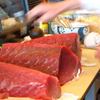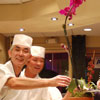A Closer Look
What is sushi?
Sushi is considered an art form. It is elegantly arranged to enhance its simplicity and natural beauty. The method of preparation, shape and taste differ somewhat depending on the prefectures in Japan. Each sushi holds its tradition and characteristic in every prefecture. Sushi is very attractive because it is prepared quickly before the customer's eyes by the sushi chef.
Sushi is NOT raw fish, but today refers to vinegary rice used in making sushi. This should not be confused with Sashimi, which is the actual term for raw fish.
Type of sushi
Nigiri-zushi
Nigiri-zushi is a fresh, delicate piece of sashimi pressed on top of vinegary rice. Nigiri-zushi means "squeezed sushi" and was originally a specialty from Tokyo. It was actually called "Edo-mae," meaning in "front of Tokyo" (Tokyo was originally called Edo) because the fresh fish came directly from the fish market at Tokyo Bay.
Maki-zushi
Maki-zushi is sushi which is rolled with rice and sheets of seaweed, then sliced into bite-sized portions. This form of sushi is extremely popular due to its amazing versatility, almost any combination of items can be used. People who are new to eating sushi will find it particularly appealing, as the many ingredients combined into a delightful taste sensation completely dispels any squeamishness associated with "raw fish." There are two types of rolled sushi: Hosomaki, or cut roll, is the most familiar, and Temaki, whish is rolled by hand into a cone shape.
Sashimi
Sashimi is fresh seafood, served raw, chilled, and sliced. The art of sashimi is in its aesthetic arrangements. Sashimi, unlike sushi, does not combine the fish with vinegary rice, therefore only the finest cuts of fish are selected by the sushi chef. There are four primary cuts used in its preparation. The first, Hira zukuri is a rectangular cut, and is primarily used for fish that are more delicate and frail. Ito zukuri is a very thin cut slice (about sixteenth of an inch thick) for fillets such as squid. Kaku zukuri is cut in cubes, approximately three-quarters of a square inch, and is used for tuna and yellowtail. Finally, Usu zukuri is a paper thin cut slice, so thin that the plate is visible through the fish.
Chirashi-zushi
Chirashi-zushi means "scattered sushi," but this simple description does not adequately prepare one for this beautifully arranged dish. In Tokyo, both cooked and uncooked seafood, vegetables and omelet are "scattered" on top of sushi rice in a bowl. In Osaka, chirashi-zushi is made of finely chopped ingredients, such as eel, fish, and ginger, which is cooked, and served with rice.
Etiquette
- Never pass food to someone using chopsticks. This act parallels passing cremated bones of a deceased relative at a Japanese funeral. If you must share food, pass them the plate so that they can pick from it instead.
- Never bite into a piece of food and then replace the other half on your plate. One you have picked something up, you should finish the piece.
- Never expect the chef to handle money. Another employee will settle the bill for you. People who handle the food never touch the money.
- Sashimi is eaten with chopsticks, never with fingers. Sashimi is dipped in a small dish with soy sauce and wasabi, to taste. Wasabi is powerful stuff, and is great when you have a cold or stuffy nose! In earlier times, Wasabi was used to kill the bacteria from the fish, so people wouldn't get sick.
- Sushi is a finger food, particularly nigiri-zushi. Don't try to demonstrate your chopsticks skills here. Pick up the sushi with your fingers, and turn it over so that you lightly dip the fish, NOT the rice in the soy sauce.
- You will also receive a small dish for soy sauce. Do not add wasabi to the dish, as it has already been placed on the fish by the chef. If you like it extremely hot, ask for the chef for extra wasabi when ordering.
- Have fun and enjoy your meals at the sushi bar.



